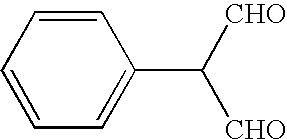Synthesis of 4-substituted phthalaldehyde
a technology of phthalaldehyde and substitutes, which is applied in the field of synthesizing 4 substitutes for phthalaldehyde, can solve the problems of undesired properties of formaldehyde and glutaraldehyde, and objectionable odor of formaldehyde, and achieves objectionable odor of glutaraldehyde. , the effect of reducing the toxicity of formaldehyd
- Summary
- Abstract
- Description
- Claims
- Application Information
AI Technical Summary
Problems solved by technology
Method used
Image
Examples
example 1
[0011]Germicidal solutions containing 0.25% of 4-fluoro-phthalaldehyde were tested at exposure times of 30 and 60 minutes. The results are shown in Table 1.
[0012]
TABLE 1Exposure TimeLog Reductions / mL(minutes)(0.25%, 20° C.) 305.660Total Kill
[0013]The results show that, under the test conditions, about 0.25% of 4-fluoro-phthalaldehyde is effective to achieve a total kill of the bacteria in from 30 to 60 minutes at a temperature of 20° C.
example 2
[0014]Germicidal solutions containing either 0.2 or 2.7% of 4-chloro-phthalaldehyde were tested at an exposure time of five minutes. The 2.7% solution included 20% isopropanol to increase solubility. The results are shown in Table 2.
[0015]
TABLE 2Compound ConcentrationLog Reductions / mL(w / v %)(20° C., 5 min) 0.25.92.7Total Kill(in 20% isopropranol)
[0016]The results show that, under the test conditions, a concentration between about 0.2 to 2.7% of the 4-chloro-phthalaldehyde is effective to achieve a total kill of all bacteria in just five minutes at a temperature of 20° C. Based on the high log reduction of the 0.2% solution, it may be possible to achieve a total kill with less than 1% of the compound. In a separate experiment, a 20% isopropanol solution containing no chlorinated compound was found to be confluent to the bacteria (more than too many bacteria remaining to count) in five minutes at 20° C., indicating that the isopropanol had no significant effect on the log reductions.
example 3
[0017]Germicidal solutions containing 0.1% of 4-bromo-phthalaldehyde were tested at exposure times of 10 and 30 minutes. The results are shown in Table 3.
[0018]
TABLE 3Exposure TimeLog Reductions / mL(minutes)(0.1%, 20° C.) 105.630Total Kill
[0019]The results show that, under the test conditions, about 0.1% of 4-bromo-phthalaldehyde is effective to achieve a total kill of the bacteria in from 10 to 30 minutes at a temperature of 20° C.
[0020]In one aspect, a germicidal composition may include a germicidally effective amount of a 4-halo-phthalaldehyde compound in an aqueous solution or other suitable diluent. The amount may be effective to kill at least 1×106 Mycobacterium terrae bacteria in contact with the composition in less than one hour, less than 30 minutes, or in less than 5 minutes, with a bacterial suspension test at a temperature of 20° C. As demonstrated in Example 1, a composition including about 0.25% of 4-fluoro-phthalaldehyde is effective to achieve a total kill of the bact...
PUM
| Property | Measurement | Unit |
|---|---|---|
| temperature | aaaaa | aaaaa |
| temperatures | aaaaa | aaaaa |
| pore size | aaaaa | aaaaa |
Abstract
Description
Claims
Application Information
 Login to View More
Login to View More - R&D
- Intellectual Property
- Life Sciences
- Materials
- Tech Scout
- Unparalleled Data Quality
- Higher Quality Content
- 60% Fewer Hallucinations
Browse by: Latest US Patents, China's latest patents, Technical Efficacy Thesaurus, Application Domain, Technology Topic, Popular Technical Reports.
© 2025 PatSnap. All rights reserved.Legal|Privacy policy|Modern Slavery Act Transparency Statement|Sitemap|About US| Contact US: help@patsnap.com



